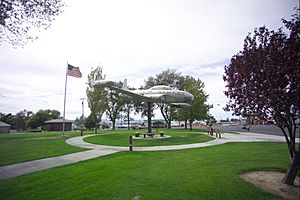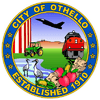Othello, Washington facts for kids
Quick facts for kids
Othello
|
||
|---|---|---|

T-33 jet in Pioneer Park
|
||
|
||

Location of Othello, Washington
|
||
| Country | United States | |
| State | Washington | |
| County | Adams | |
| Government | ||
| • Type | Mayor–council | |
| Area | ||
| • Total | 3.98 sq mi (10.31 km2) | |
| • Land | 3.98 sq mi (10.31 km2) | |
| • Water | 0.00 sq mi (0.00 km2) | |
| Elevation | 1,060 ft (323 m) | |
| Population
(2020)
|
||
| • Total | 8,549 | |
| • Density | 2,148.0/sq mi (829.2/km2) | |
| Time zone | UTC-8 (Pacific (PST)) | |
| • Summer (DST) | UTC-7 (PDT) | |
| ZIP codes |
99327, 99332, 99344
|
|
| Area code | 509 | |
| FIPS code | 53-52215 | |
| GNIS feature ID | 1507216 | |
Othello is a city located in Adams County, Washington, United States. In 2020, its population was 8,549 people. This was a 16 percent increase from the 2010 census.
Othello is found in the middle of the Columbia Basin Project. It is about 100 miles (160 km) southwest of Spokane. The city is also 25 miles (40 km) south of Interstate 90 near Moses Lake. You can reach Othello by State Route 17 and State Route 26.
Contents
History of Othello
Early Settlers and Naming the Town
The first white settlers arrived in the Othello area in 1884. Two brothers, Ben and Sam Hutchinson, built a cabin by Crab Creek. More people started to settle there after 1900. A post office was opened in 1904. The name "Othello" was chosen in a public contest. It was named after another post office in Tennessee.
The Railroad Era
In 1907, the Milwaukee Railroad built tracks through Adams County. A hotel was built for railroad workers in 1912. This hotel is now known as the Old Hotel and Art Gallery. The railroad officially made Othello a town stop. They built a railyard and a wooden roundhouse for their steam trains.
The wooden roundhouse burned down in 1919. It was replaced with a brick building that lasted for many years. More businesses and people came to Othello. The town officially became a city on May 31, 1910. The railroad was very important for Othello's early growth. However, the railroad stopped operating in 1980.
Growth with the Columbia Basin Project
The Bureau of Reclamation opened offices in Othello in 1947. This helped the town avoid decline when rail shipping became less popular. In the early 1950s, the Columbia Basin Project brought irrigation to the Othello area. This project supplied water for farming. Before this, water only came from Crab Creek and local wells.
The new water arrived through the Potholes East Canal. With irrigation available, a special land drawing was held in Othello. On May 31, 1952, 42 names were chosen from over 7,000 entries. These lucky people got the chance to buy the newly irrigated land.
Modern Developments
From 1951 to 1973, the 637th Radar Squadron operated the Othello Radar Station nearby. In 1958, an ice plant opened to help move farm products by train. In the early 1960s, frozen food packaging started in Othello. This has become the main industry for the city.
Since 1998, Othello has hosted the Sandhill Crane Festival. This festival celebrates the yearly arrival of sandhill cranes. They come to the nearby Columbia National Wildlife Refuge.
Geography and Climate
City Area
Othello covers a total area of about 3.81 square miles (9.87 square kilometers). All of this area is land.
Understanding Othello's Climate
Othello has a semi-arid climate. This means it is generally dry, but not a desert. It gets some rain, but not a lot. The weather can have big changes between seasons.
| Climate data for Othello, Washington | |||||||||||||
|---|---|---|---|---|---|---|---|---|---|---|---|---|---|
| Month | Jan | Feb | Mar | Apr | May | Jun | Jul | Aug | Sep | Oct | Nov | Dec | Year |
| Record high °F (°C) | 64 (18) |
67 (19) |
79 (26) |
91 (33) |
99 (37) |
106 (41) |
111 (44) |
114 (46) |
102 (39) |
91 (33) |
73 (23) |
63 (17) |
114 (46) |
| Mean daily maximum °F (°C) | 35 (2) |
43 (6) |
53 (12) |
61 (16) |
69 (21) |
76 (24) |
83 (28) |
83 (28) |
74 (23) |
61 (16) |
45 (7) |
35 (2) |
60 (15) |
| Mean daily minimum °F (°C) | 23 (−5) |
28 (−2) |
31 (−1) |
36 (2) |
43 (6) |
49 (9) |
54 (12) |
54 (12) |
47 (8) |
37 (3) |
31 (−1) |
24 (−4) |
38 (3) |
| Record low °F (°C) | −26 (−32) |
−26 (−32) |
6 (−14) |
16 (−9) |
23 (−5) |
31 (−1) |
34 (1) |
36 (2) |
26 (−3) |
14 (−10) |
−14 (−26) |
−15 (−26) |
−26 (−32) |
| Average precipitation inches (mm) | 0.93 (24) |
0.85 (22) |
0.86 (22) |
0.62 (16) |
0.73 (19) |
0.52 (13) |
0.39 (9.9) |
0.33 (8.4) |
0.40 (10) |
0.57 (14) |
1.04 (26) |
1.21 (31) |
8.45 (215.3) |
Economy and Jobs
Othello is a major center for farming. It also has many companies that process and store food, especially potatoes. About 1.5 billion pounds of frozen potato products are processed here each year. This makes up 15 percent of all frozen potato production in North America.
More than 700 jobs in Othello are related to processing potatoes. Big companies like McCain Foods and J. R. Simplot have facilities here. However, the farming economy faces a challenge. There is a growing shortage of water in the area.
Population and People
| Historical population | |||
|---|---|---|---|
| Census | Pop. | %± | |
| 1920 | 649 | — | |
| 1930 | 397 | −38.8% | |
| 1940 | 332 | −16.4% | |
| 1950 | 526 | 58.4% | |
| 1960 | 2,669 | 407.4% | |
| 1970 | 4,122 | 54.4% | |
| 1980 | 4,454 | 8.1% | |
| 1990 | 4,638 | 4.1% | |
| 2000 | 5,847 | 26.1% | |
| 2010 | 7,364 | 25.9% | |
| 2020 | 8,549 | 16.1% | |
| U.S. Decennial Census | |||
Since the 1980s, many immigrants from Latin America have moved to Othello. They often come for seasonal farm jobs or as migrant workers. This has made Othello a very diverse city.
Othello's Population in 2020
In 2020, Othello had 8,549 people living there. There were 2,616 housing units and 2,429 families. The city had about 2,137 people per square mile.
The people in Othello come from many different backgrounds:
- 54.7% were White.
- 0.1% were African American.
- 1.2% were Native American.
- 1.4% were Asian.
- 25.3% were from other races.
- 17.3% were from two or more races.
- A large part of the population, 75.6%, were of Hispanic or Latino origin.
The average age in Othello was 25.1 years old. A big part of the population, 39.6%, was under 18 years old. About 8.2% of the people were 65 or older. The population was almost evenly split between females (50.3%) and males (49.7%).
The average income for a household was $58,450. About 21.8% of the people in Othello lived in poverty.
Othello's Population in 2010
In 2010, Othello had 7,364 people. There were 2,108 households and 1,669 families. The city had about 1,933 people per square mile.
The racial makeup of the city was:
- 53.4% White.
- 0.5% African American.
- 2.2% Native American.
- 1.2% Asian.
- 39.6% from other races.
- 3.2% from two or more races.
- 74.7% of the population was Hispanic or Latino.
Many households (57.8%) had children under 18 living with them. The average household size was 3.46 people. The average family size was 3.91 people.
The average age in Othello in 2010 was 25.6 years. About 37.9% of residents were under 18. And 8.1% were 65 years or older.
Sister City
Othello has a special connection with another city far away. This is called a sister city relationship:
- Wulensi, Nanumba South District, Ghana.
Notable People from Othello
- Pee Wee (born Irvin Salinas), a singer
- Davey Richards, a professional wrestler
- Bill Crow, a jazz musician and author
- Stephen Beus, a pianist
- Jim Sandusky, a football player
See also
 In Spanish: Othello (Washington) para niños
In Spanish: Othello (Washington) para niños


